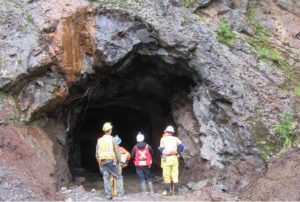Skeena probes untested areas at former B.C. gold mine

Skeena's Snip Mine 44 Portal and technical crew. Source: Skeena Resources Ltd.

Skeena Resources Ltd. [SKE-TSXV; SKREF-OTC] on Wednesday May 16 released analytical results from the first eight holes of the recently initiated Phase II underground drilling program at the company’s 100%-owned Snip Project in British Columbia’s Golden Triangle region.
Previously owned by Barrick Gold Corp. [ABX-TSX, NYSE], the former Snip Mine was a high-grade mine that produced approximately 1 million ounces of gold from 1991 to 1999, at an average gold grade of 25 g/t at a 12 g/t reserve cut off.
Snip was also a fly-in/fly-out operation that was dependent on diesel fuel. Concentrates were transported from the site by hovercraft in the summer and by plane in the winter. The project now benefits from excellent available infrastructure, including an airstrip, a new nearby hydro development and proximity to power and roads.
Skeena Chairman Ron Netolitzky was instrumental in developing the deposit and is intimately familiar with the area and its history.
The 2018 Phase II diamond drill program totalling 11,000 metres is being drilled from existing underground infrastructure utilizing two drill rigs. The 2018 program is building upon the data gathered from the 2017 Phase I campaign and is designed to further delineate known mineralization in areas with low drill density, and to expand newly modelled zones via widely spaced exploratory step-out drill holes.
Recent drilling has focused on remnants of the Twin Zone, an area that accounted for 60% of Snip’s production.
Drilling on the eastern strike-extension of the Twin Zone is focusing on increasing drill density and geological confidence in areas with a paucity of historical drill intercepts. UG18-072 intersected 14.49 g/t gold over 4.05 metres. This intercept expands the Twin Zone at a vertical depth of 320 metres below surface and 100 metres up-plunge from previously reported broad intervals of 19.26 g/t gold over 11.85 metres and 11.21 g/t gold over 5.95 metres in UG17-035 at a vertical depth of 375 metres below surface.
This new mineralization is also corroborated by the previously reported intercept of 35.49 g/t gold over 4.35 metres in US17-036. Skeena said there is a high potential for further discovery here as the historical drill hole pierce points are widely-spaced and the Twin Zone remains untested by drilling at depth and along strike, the company said.
Meanwhile, drill stations in the footwall development that are targeting the Eastern Twin Zone also cross the 412 Veining Corridor. Currently, drilling is expanding upon and adding geological confidence in this area. UG18-064 intersected 11.74 g/t gold over 4.50 metres and confirms he continuity of the 412 Veining, as the intercept is positioned 25 metres west of historical drill hole UG-1723, which intersected 25.90 g/t gold over 1.00 metres. Drill hole spacings in the 412 Veining Corridor average 25 metres.
Skeena said the ongoing 11,000-metre Phase II infill and exploratory drill program at Snip is well underway with 28 drill holes completed to date in the Eastern Twin and 412 Veining Corridor Areas.
The company has also relocated a drill rig to test the newly modelled 200 Footwall Corridor now that services have been provided to the necessary underground drill bays. The 200 Footwall received limited underground drilling from previous operators and was successfully tested by 2016 Skeena drilling which intersected 16.24 g/t gold over 13.50 metres in a previously undrilled area.
The geological similarities to the Twin Zone, coupled with the lack of drill testing make the 200 Footwall a substantial exploration target and a large portion of the 2018 program is designed to expand on this newly modelled and largely untested area.
Analytical results from the Phase II program will be disclosed in a timely manner once received, Skeena said.
On Wednesday, Skeena shares eased 2.00% or $0.01 to 49 cents on volume of 135,200. The 52-week range is 80 cents and 40 cents.
